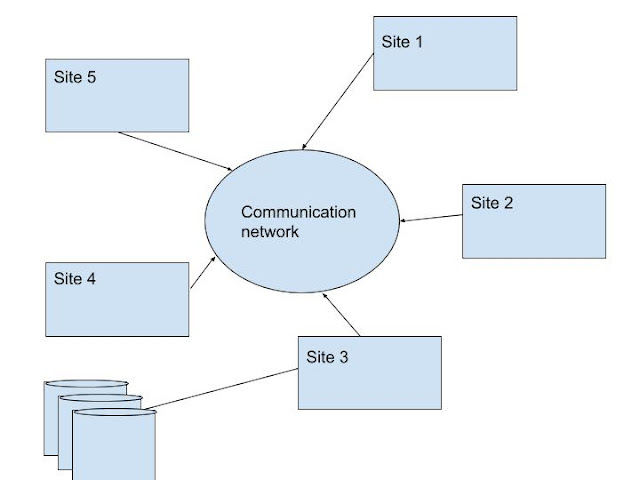Centralized and Client-Server Architectures:
Centralized Architectures:
- In a centralized database, there is a single database file at one location in
the network
- Multiple users can access this single database, it is called a centralized
database
- This kind of database provides multiple advantages
- As there is an only single database file, it is easier to get a complete view
of data
Here we have installed our server on Site3, other sites can remotely access
to the database. For e.g.: If Site5 needs any data then they can request it
to site3 and retrieve data easily
Advantages of Centralized Database:
- The data integrity is maximized as the whole database is stored at a single
physical location. This means that it is easier to coordinate the data and it
is as accurate and consistent as possible
- The data redundancy is minimal in the centralized database
- Since all the data is in one place, there can be stronger security measures
around it. So, the centralized database is much more secure.
- Data is portable as it is stored in one location
- It is cheaper than other types of database, as it requires lower power
consumption and maintenance
- All the information in the centralized database can be easily accessed
from the same location and at the same time
Disadvantages:
- Since all the data is at one location, it takes more time to search and
access it.
- If the network is slow, this process takes even more time
- There is a lot of data access traffic for the centralized database.
This can create a bottleneck situation
- Since all data is at the same location, if multiple users try to access it
simultaneously it creates a problem and reduces the efficiency
- If there are no database recovery measures in place and a system failure
occurs, then all data in the database will be destroyed
Client-Server Architectures
- The most important and most widely used distributed system architecture
- Client and Server roles are assigned and are changeable

A system can act as a server or client depending on the requirement
Client/server architecture is a computing model in which the server hosts,
delivers and manages most of the resources and services to be consumed by
the client. This type of architecture has one or more client computers connected
to a central server over a network or internet connection. This system shares
computing resources.
Centralized and Client-Server Architectures:
Centralized Architectures:
- In a centralized database, there is a single database file at one location in
the network
- Multiple users can access this single database, it is called a centralized
database
- This kind of database provides multiple advantages
- As there is an only single database file, it is easier to get a complete view
of data
Here we have installed our server on Site3, other sites can remotely access
to the database. For e.g.: If Site5 needs any data then they can request it
to site3 and retrieve data easily
Advantages of Centralized Database:
- The data integrity is maximized as the whole database is stored at a single
physical location. This means that it is easier to coordinate the data and it
is as accurate and consistent as possible
- The data redundancy is minimal in the centralized database
- Since all the data is in one place, there can be stronger security measures
around it. So, the centralized database is much more secure.
- Data is portable as it is stored in one location
- It is cheaper than other types of database, as it requires lower power
consumption and maintenance
- All the information in the centralized database can be easily accessed
from the same location and at the same time
Disadvantages:
- Since all the data is at one location, it takes more time to search and
access it.
- If the network is slow, this process takes even more time
- There is a lot of data access traffic for the centralized database.
This can create a bottleneck situation
- Since all data is at the same location, if multiple users try to access it
simultaneously it creates a problem and reduces the efficiency
- If there are no database recovery measures in place and a system failure
occurs, then all data in the database will be destroyed
Client-Server Architectures
- The most important and most widely used distributed system architecture
- Client and Server roles are assigned and are changeable
A system can act as a server or client depending on the requirement
Client/server architecture is a computing model in which the server hosts,
delivers and manages most of the resources and services to be consumed by
the client. This type of architecture has one or more client computers connected
to a central server over a network or internet connection. This system shares
computing resources.

Comments
Post a Comment